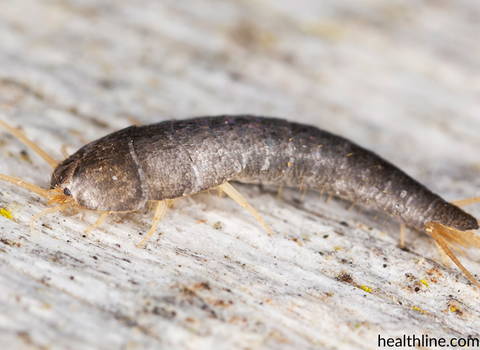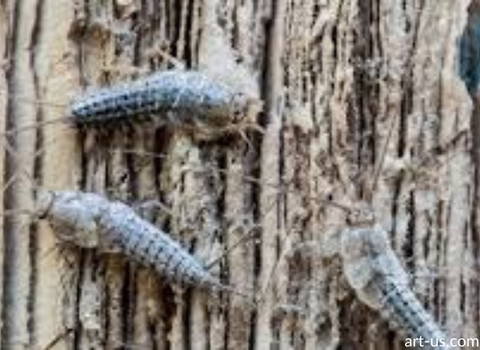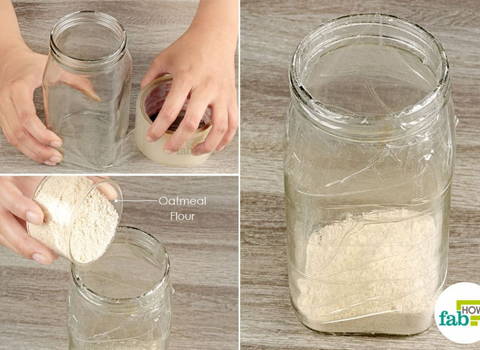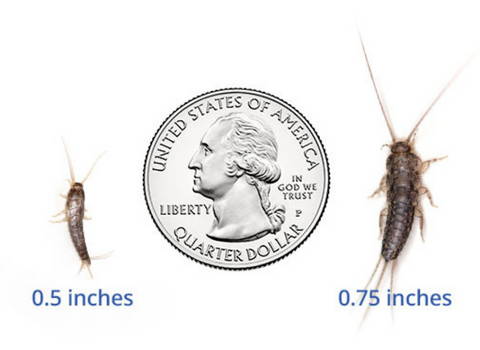Baby Silverfish Bugs: What Do They Look Like
Silverfish belong to the insect group called bristletails and are considered hardy pests that can survive several weeks without water and for months without food. The presence of nymphs or baby silverfish only indicates that there is an infestation of which you are not fully aware.
The lifespan and development of silverfish babies depend on their surrounding environment. The babies of silverfish mature quicker and also live longer when they are staying in warm temperatures.
Throughout the silverfish lifespan, they will choose to stay in humid areas with temperatures ranging from 70 to 90° like the temperature in laundry rooms. This means that it is no surprise if you see them in rooms with high humidity. These silverfish live on an average of 3 years when they find a suitable place as their habitat.
What Do Baby Silverfish Look Like?
Silver fish babies are white and soft, but otherwise, they look like adults. Nymphs are known to have the same long antennae as adults. They have six legs, tapered bodies that are ending with three limbs that look like a fishtail as the limbs fan out.
They will only change their colour as they reach the adult stage, which is the major change that will be noticeable. That is the only significant difference that these baby silverfish have from adults.
These babies molt four times before they start developing scales before they turn into full-sized adult silverfish. An adult-sized silverfish is usually half an inch long.
Babies are usually 1/16 inch long. Unlike other insects, these pests do not undergo metamorphosis. So, the appearance of baby silverfish will not be too different than adults. This makes identification easier as well.
How Often Do Female Silverfish Reproduce?
Female adults would usually lay eggs in hidden places around your house. Eggs would usually take around 20 to 40 days to hatch. Nymphs or baby silverfish will mature in a matter of months when their environment is ideal for growing. During the cold season, the development period of adults will usually take two years to complete.
When mating, silverfish will do a sort of dance until both silverfish touch their antennae and then proceed to chase each other. They will then spin erratically in various positions until they reach the time when they are ready to start mating.
The dance that they do is considered once in a lifetime as one silverfish female rarely lays more than a batch of eggs in their lifetime. Clusters of eggs will usually have 50 eggs each time. The eggs are often laid in wall cracks. It is impossible to see these eggs without the use of a microscope.
What Do Baby Silverfish Eat?
Nymphs have the same diet as adults. Baby silverfish feed on high protein and starchy items. If you are starting to suspect that you have a silverfish infestation, you might want to start checking on every part of your house for signs of their presence.
Signs of Silverfish Infestation
If you are worried about a possible infestation in your home, there are some signs that you should look out for. The following are signs that an ongoing infestation is in your home:
Nighttime Activity
These pests always come out and only feed after dark. Spotting these nocturnal pests at night means that there is a pest problem going on.
Sightings
Just the sight of nymphs in your home only means that there is current indoor breeding. This is an obvious sign that an infestation has already started.
Damaged Books
Silverfish naturally feed on books. When they start nibbling books, especially old books, they will leave ragged pages and binding with irregular holes. Seeing books in this state only means that the infestation is getting worse and other books in the same storage are possibly infected as well.
Yellow Stains
These bristletails are also known to feed on individual fibres of the fabric. As they do this, they leave yellow stains behind, especially on linen. Seeing these stains can either be a sign of silverfish or the presence of other pests.
It is important that you check on the other signs to know which pest problems you are dealing with. Once you confirm the presence of silverfish in your home, it is necessary that you act immediately and start on some methods to get rid of silverfish effectively.
How Do Silverfish Get into Your House?
The flat body of silverfish and their notable running speed allow these insects to slip swiftly through narrow gaps, cracks and crevices on walls, doors, or windows. Since females can lay up to three eggs, these can hatch within a month.
Also, a single silverfish, under ideal living conditions, can live for about three years. This is enough time for them to build generations and continue infesting your home or establishment as their population continues to grow.
These pests prefer damp areas and can also enter your home through drains and leaky pipes. They love thriving in cool and dark basements and bathrooms with high humidity or high moisture levels. Some establishments that are prone to silverfish pest problems are factories with machines generating condensation and steam, laundromats, and laundromats.
Damages that Silverfish Does in Your House
One good thing about baby silverfish unlike other pests is that they are harmless to humans. Since they are harmless, you might think that it will not be a problem to just leave them inside your house. However, you might change your mind once you see a larger adult scurrying across the floor or crawling in your bathtub.
What makes them a major problem in your house is their expensive diet and their tendency to wreak havoc. They feed on paper products that contain paste or glue. They also love to eat starches in cereals and also love the protein found in dried beef and food for pets.
They Also Do Damages in Commercial Establishment
Aside from your house, they also invade commercial establishments. Some of the common establishments that these pests get into are cafeterias and restaurants. Workers in these establishments would usually find these insects eat through bags of flour in pantries.
Shipping and storage facilities are also targets of these pests. Employees of these establishments would sometimes find out that these insects already chewed holes into cardboard boxes. These insects can also infest office buildings and affect documents in cabinets and file rooms.
Other things that they eat are wallpaper paste, curtains, and carpets. They also eat linen, cotton, fabric and even silk. They also leave yellow discoloration on the items that they infest. So, if you find any clothes with holes, it is most likely that these insects have caused it.
With all these damages, it is important that you know how to attack a silverfish infestation and act immediately before your pest problems worsen.
How to Get Rid of Silverfish Infestation Before It Gets Worse?
Keep in mind that the presence of baby silverfish means that adults are also nearby. This is a clear indication that you have to work on the infestation as soon as possible before it gets worse.
Just imagine how the infestation would worsen if you saw one and did nothing to address the issue. The next few months will allow them to grow their population and do serious damages to your home.
As much as possible, you want to address it immediately and not wait for a later date. Some of the things that you can do if your house is infested are the following:
Trap them using the glass jar method. This involves the use of items that will pull silverfish off.
Use a newspaper to attract silverfish and make them come out of their hiding places for it. Just wet the newspaper and close it on the other end. Instead of unwrapping it, you can just burn it to immediately kill the ones that got into the newspaper.
Use spices like bay leaves and sage as these are smells that these insects hate.
Make use of lavender oil, citrus sprays, cucumber, and mothballs.
Boric acid can be used to control and kill silverfish. Boric acid not only kills the mature silverfish but also their babies. It is considered a long-lasting solution especially when the treated area is kept dry for at least a year.
Though it is a fact that silverfish can live as long as possible inside houses, you can do things that will prevent them from infesting your home. You can control them easily if you will take advantage of your knowledge about their food source, habitats, as well as their reproduction cycle.
Products that we recommend to help you deal with the presence of silverfish are the following:
Tips to Prevent Silverfish from Coming Back
After you started methods in controlling and eliminating these insects, you should also learn how to prevent them from coming back. Things that you should observe doing in your home or establishment are the following:
Use bathroom fans.
When taking showers, it is recommended that you use bathroom fans.
Dehumidifier
Lessen humidity in certain rooms with high humidity by utilizing a dehumidifier.
Improve ventilation.
To improve ventilation in your crawl space or basements, open it up as these insects are commonly found in these areas.
Get rid of old papers.
Since silverfish are attracted to paper products, it is recommended that you dispose of old magazines and newspapers.
Remove debris.
Get rid of leaves as well as any wet debris around your house.
Try to keep everything dry.
Preserve your flour, pasta, cereals, and other dry foods in airtight containers.
Dust and vacuum regularly.
Make it a habit to clean up food crumbs.
Avoid putting paper materials and cardboard in your basement.
These preventive measures will help keep your home free of these insects once you learned how to eliminate them.





